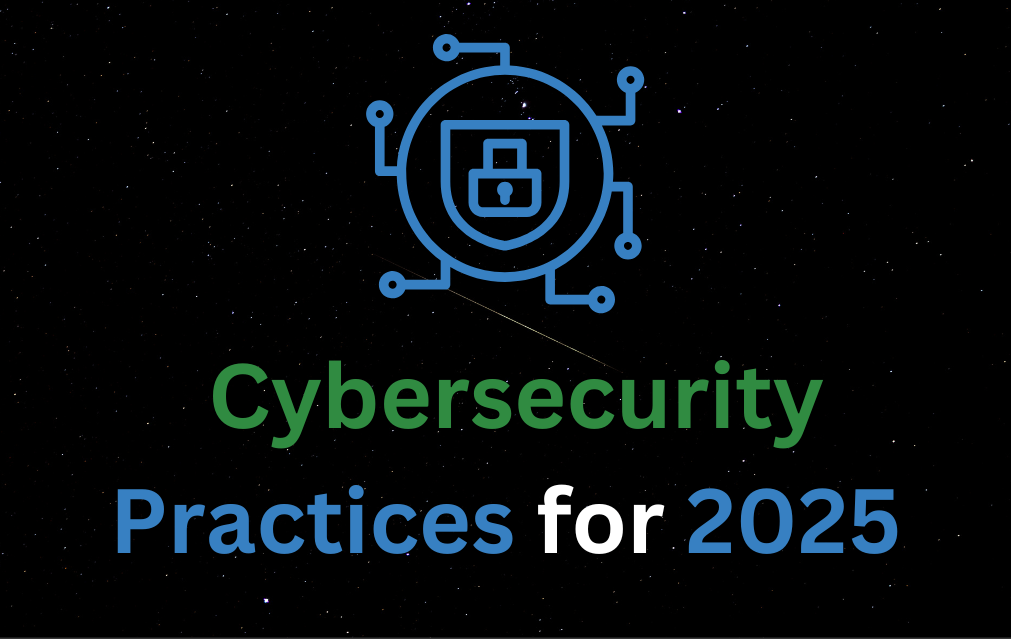Essential Cybersecurity Practices – Introduction
With cyber threats evolving rapidly, 2025 demands a proactive approach to digital security. From AI-driven cyberattacks to advanced phishing scams, individuals and businesses must prioritize cybersecurity to safeguard sensitive data. This guide covers key cybersecurity practices to protect yourself online.
1. Strengthen Your Passwords & Authentication
Weak passwords are a major vulnerability. Follow these best practices:
A. Use Strong, Unique Passwords
✅ At least 16 characters long
✅ A mix of uppercase, lowercase, numbers, and symbols
✅ Avoid personal info (birthdates, names, etc.)
✅ Use passphrases (e.g., Purple$GiraffeRunsFast!)
B. Enable Multi-Factor Authentication (MFA)
MFA adds an extra layer of security by requiring:
- A password + a one-time code (sent via SMS, app, or email).
- Best option: Authenticator apps like Google Authenticator or Authy.
2. Secure Your Devices & Networks
A. Keep Software & OS Updated
- Updates patch vulnerabilities exploited by hackers.
- Enable automatic updates for your OS, browser, and apps.
B. Use a Secure Internet Connection
🚫 Avoid public Wi-Fi (hotels, cafes, airports) unless using a VPN.
✅ Encrypt your home network with WPA3 security.
✅ Change default router passwords & firmware updates.
C. Install Reliable Antivirus & Firewall
- Protect against malware, ransomware, and phishing attacks.
- Recommended tools: Bitdefender, Kaspersky, Norton, or Malwarebytes.
3. Protect Against Phishing & Scams
Cybercriminals use phishing emails, fake websites, and social engineering to steal data.
🚩 Warning Signs of a Phishing Attempt:
🔹 Urgent messages pressuring immediate action.
🔹 Email sender address slightly misspelled (e.g., paypaI.com instead of paypal.com).
🔹 Suspicious links or attachments.
✅ Best Practices:
✔ Never click on suspicious links—hover over them to preview.
✔ Verify emails by contacting the company directly.
✔ Use email security tools like Google Safe Browsing or Microsoft Defender.
4. Data Privacy & Encryption
Keeping personal and business data private is crucial in the digital age.
A. Encrypt Your Files & Communications
🔒 Use end-to-end encryption (E2EE) tools for messaging & emails:
- Messaging: Signal, Telegram (secret chats), or WhatsApp.
- Email Encryption: ProtonMail, Tutanota.
B. Secure Your Cloud Storage
Cloud data is vulnerable to breaches. Steps to secure it:
✅ Use encrypted cloud services (Sync.com, Tresorit, Proton Drive).
✅ Enable 2FA on cloud accounts.
✅ Regularly back up important files offline.
5. Protect Against AI-Powered Cyber Threats
With AI being used in deepfake scams, automated hacking, and data breaches, cybersecurity measures must evolve.
🔹 AI-Driven Threats in 2025:
- Deepfake videos used for fraud.
- AI-powered phishing attacks that mimic real people.
- Automated malware that adapts to security defenses.
✅ How to Stay Safe:
✔ Verify video & voice messages before taking action.
✔ Use AI-powered threat detection software.
✔ Regularly monitor bank accounts & online profiles for unusual activity.
Conclusion
In 2025, cybersecurity is no longer optional—it’s a necessity. By implementing strong authentication, securing devices, avoiding phishing scams, and staying informed about AI-driven threats, you can protect your personal and business data from cybercriminals.
🚀 Take action today: Secure your accounts, encrypt your data, and stay vigilant!
Note: All Of Our Articles Are Written By Artificial Intelligence And Reviewed By Researchers.
